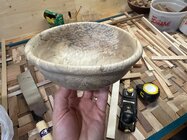While turning some spatled maple I noticed powdered post beetle holes on the bowl exterior on one side only. Figuring the critters would not have a resistance to HSS I finished the bowl down to about a 1/8 wall thickness. The bowl is now in a plastic bag while I debate what to do with it. The holes are about even in number inside and outside but hard to count.
All the advice I’ve seen is on sterilizing blanks not a bowl with a fraction of the overall size. So far I’ve microwaved the bowl for two minutes and put it on the dash of the car in the sun, where temps got into the 110° for a couple of hours and 136° for an hour or so. Based on a twenty year old UW extension page I may try temperature shock - quickly going from very hot to the freezer.
Many of you are saying ‘throw it out’ but it’s an interesting problem to solve. It may just live in a bag long term as an experiment. What else should I try?
All the advice I’ve seen is on sterilizing blanks not a bowl with a fraction of the overall size. So far I’ve microwaved the bowl for two minutes and put it on the dash of the car in the sun, where temps got into the 110° for a couple of hours and 136° for an hour or so. Based on a twenty year old UW extension page I may try temperature shock - quickly going from very hot to the freezer.
Many of you are saying ‘throw it out’ but it’s an interesting problem to solve. It may just live in a bag long term as an experiment. What else should I try?





